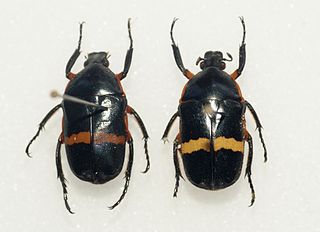
Beetles are insects that form the order Coleoptera, in the superorder Holometabola. Their front pair of wings are hardened into wing-cases, elytra, distinguishing them from most other insects. The Coleoptera, with about 400,000 described species, is the largest of all orders, constituting almost 40% of described insects and 25% of all known animal species; new species are discovered frequently, with estimates suggesting that there are between 0.9 and 2.1 million total species. Found in almost every habitat except the sea and the polar regions, they interact with their ecosystems in several ways: beetles often feed on plants and fungi, break down animal and plant debris, and eat other invertebrates. Some species are serious agricultural pests, such as the Colorado potato beetle, while others such as Coccinellidae eat aphids, scale insects, thrips, and other plant-sucking insects that damage crops. Some others also have unusual characteristics, such as fireflies, which use a light-emitting organ for mating and communication purposes.

Trogidae, sometimes called hide beetles, is a family of beetles with a distinctive warty or bumpy appearance. Found worldwide, the family includes about 300 species contained in four or five genera.

Dynastinae or rhinoceros beetles are a subfamily of the scarab beetle family (Scarabaeidae). Other common names – some for particular groups of rhinoceros beetles – include Hercules beetles, unicorn beetles or horn beetles. Over 1,500 species and 225 genera of rhinoceros beetles are known.

Flower chafers are a group of scarab beetles comprising the subfamily Cetoniinae. Many species are diurnal and visit flowers for pollen and nectar, or to browse on the petals. Some species also feed on fruit. The group is also called fruit and flower chafers, flower beetles and flower scarabs. There are around 4,000 species, many of them still undescribed.

Cotinis nitida, commonly known as the green June beetle, June bug or June beetle, is a beetle of the family Scarabaeidae. It is found in the eastern United States and Canada, where it is most abundant in the South. It is sometimes confused with the related southwestern species figeater beetle Cotinis mutabilis, which is less destructive.

Deltochilum valgum is a nocturnal, Neotropical species of dung beetle in the family Scarabaeidae, which has evolved a predatory lifestyle. While most other members of the true dung beetle subfamily feed on faeces or decomposing matter, D. valgum is highly specialised for eating millipedes; such a transition from scavenger to carnivore is rare. Whether this is novel adaption in this species or an ancestral adaption in the genus is unclear; at least two other species, Deltochilum kolbei and D. viridescens, which are not particularly closely related to D. valgum, also kill and feed on millipedes.

Arniocera auriguttata is a species of moth of the family Thyrididae. It is found in South Africa.

Monkey beetles are scarab beetles, a group of around 70 genera and 850 described species within the tribe Hopliini. The placement of this tribe within the family Scarabaeidae is uncertain between Melolonthinae and Rutelinae. Many species visit flowers for pollen and nectar, or browse on the petals. The beetles are important pollinators of Aizoaceae and Asteraceae in grazed and ungrazed areas, as well as many others.
This list of fossil arthropods described in 2013 is a list of new taxa of trilobites, fossil insects, crustaceans, arachnids and other fossil arthropods of every kind that have been described during the year 2013. The list only includes taxa at the level of genus or species.

Pachnoda interrupta, commonly known as the sorghum chafer, is a species of beetle of the family Scarabaeidae and subfamily Cetoniinae.

Trichostetha is a genus of beetle in the scarab beetle family. It is endemic to southern Africa, and its species most commonly occur in mountainous terrain. The genus includes several species that have only recently been described, as well as many species lacking a description of any of the larval stages. Except for T. fascicularis and its subspecies, the species comprising Trichostetha have small ranges of distribution, frequently in the Cape Floral Region of South Africa. The genus is believed to be related to Odontorrhina.

Chondrorrhina is a genus of fruit and flower chafers belonging to the family Scarabaeidae, subfamily Cetoniinae, found in Africa.

Cremastocheilini is a tribe of scarab beetles in the family Scarabaeidae. There are about 50 genera in the tribe Cremastocheilini.

Dyscinetus is a genus of rice beetles in the family Scarabaeidae. There are more than 20 described species in Dyscinetus.
2015 in paleoentomology is a list of new fossil insect taxa that were described during the year 2016, as well as other significant discoveries and events related to paleoentomology that were scheduled to occur during the year.
Delopleurus parvus, is a species of dung beetle found in India, Sri Lanka and Nepal.
Garreta smaragdifer is a species of dung beetle native to India and Sri Lanka.

Enochrus (Methydrus) esuriens, is a species of water scavenger beetle found in Indochina, Korea, China, Japan, Bhutan, Iran, Iraq, Nepal, India, Pakistan, Philippines, Sri Lanka, Vietnam, Sunda Island, Saudi Arabia and Australia.

Chaetodera regalis, common name the royal tiger beetle, is a species of tiger beetle found in Sub-Saharan Africa, especially in the south-east. It is found in riverine habitats.















